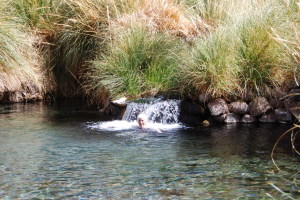 Atacama Lodge exterior
Atacama Lodge exterior
The moving and shaking isn’t over yet. Yesterday we felt another milder earthquake right at lunch time. But I don’t think that was as destructive in the north. It was slower but lasted quite a few seconds. People continued drinking their Chilean wines and the freshly made strawberry juice rehashing their morning adventures.
The late afternoon (5-ish) a group of us were taken to a pueblito called Toconado which is fighting a effort by owners of lithium mines in the area to control water. Sympathiz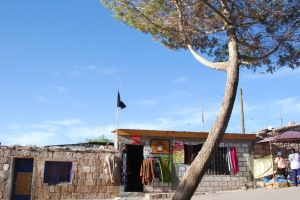 ers with the water freedom hang black flags outside their houses. Most of the citizens work in lithium mines and earn pretty decent wages, but they don’t want to lose their rights to the scarce water that flows through a deep canyon river that goes right through their village. As a community, each family can receive water from the irrigation set up once a week. The houses, all adobe and one story, look tiny but walk through the door and they go on forever. Some have shops, and have pet llamas, always dogs, and in the one we visited, the lady was knitting toy llama
ers with the water freedom hang black flags outside their houses. Most of the citizens work in lithium mines and earn pretty decent wages, but they don’t want to lose their rights to the scarce water that flows through a deep canyon river that goes right through their village. As a community, each family can receive water from the irrigation set up once a week. The houses, all adobe and one story, look tiny but walk through the door and they go on forever. Some have shops, and have pet llamas, always dogs, and in the one we visited, the lady was knitting toy llama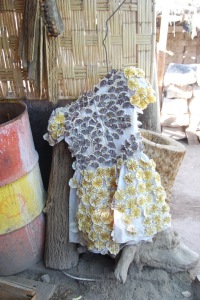 s using cactus needles. What a great idea. She displayed a dress she made out of plant material. There are gardens in this town but mostly of trees – where there is a drop of water, a tree seems to sprout – like the tamarua which only needs water the first month of its life and then survives on what it’s deep roots can find. Isn’t God amazing?
s using cactus needles. What a great idea. She displayed a dress she made out of plant material. There are gardens in this town but mostly of trees – where there is a drop of water, a tree seems to sprout – like the tamarua which only needs water the first month of its life and then survives on what it’s deep roots can find. Isn’t God amazing?

Standing in the salt fields waiting for flamingos to fly at sunset.
This was a prelude to visit salt flats that boggle the mind. As it is, the land goes on forever and is flat as an enchilada. Then there is Laguna Chaxa where the avocets (birds with long thin black beaks) and three types of flamingos nest and fly in and out of lagoons. (foto below.) In this par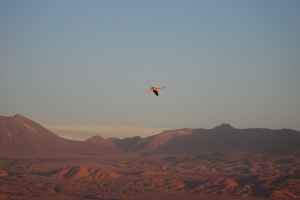 t of Chile live three of the six types of flamingos in the world. There are the Andean flamingos which are pink with black and red feathers and have red knees; the Chilean which are mostly white with yellow legs, and the James Flamingo, smaller with bigger legs and are the darkest pink. When the sun sets each day, you can catch the flamingos flying around the lagunas right in the middle of the salt flats. The wind is strong and the suns departure casts incredible colors on the Andes behind us. Then, poof, it’s dark as we return to our headquarters and the Milky Way and Jupiter are bright as Christmas lights.
t of Chile live three of the six types of flamingos in the world. There are the Andean flamingos which are pink with black and red feathers and have red knees; the Chilean which are mostly white with yellow legs, and the James Flamingo, smaller with bigger legs and are the darkest pink. When the sun sets each day, you can catch the flamingos flying around the lagunas right in the middle of the salt flats. The wind is strong and the suns departure casts incredible colors on the Andes behind us. Then, poof, it’s dark as we return to our headquarters and the Milky Way and Jupiter are bright as Christmas lights.
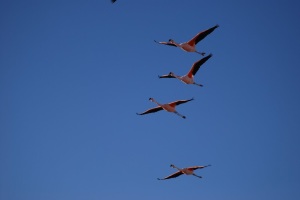
Chilean, James and Andean Flamingos in flight.
This morning, rising at 4:30, five of us were taken by van to El Tatio, elevation 4320 meters (approximately14,000 feet). There geysers put on a magic show at dawn when the temperature is 5 degrees or more below zero centigrade. (I had to inaugerate my Antartica jacket.) At that hour, the steam rises up as tall as the mountains. As the day warms up, the geysers are less obvious and are reduced to bubbling water in holes, no steam. Although this is a two hour trip one way over horrid roads, El Tatio has become a tourist mecca. And some of the less modest take off their clothes and jump in one of the hot pools. Not us, of course. My “Hair” days are over.
Coming and going, we saw lots of llama (domesticated but cared for like sheep 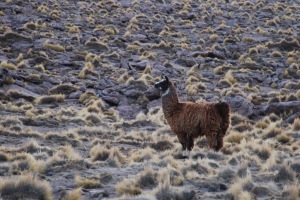 and goats), wild vicuna and rhea, who don’t stay close very long; fat Andean geese (white with black feathers), and a funny little rabbit-like animal called a Bizcacha, which has a long tail and leaps like a kangaroo. Mind you, on the entire excursion , we did not seen a single tree even miles and miles away over the landscape – just rocks and sometimes clumps of pasta brava (brave grass) – which llamas and vicuna eat. The thick grass rounds presse like gold bubble wrap thrown against a brown wall underneath a vibrant blue sky.
and goats), wild vicuna and rhea, who don’t stay close very long; fat Andean geese (white with black feathers), and a funny little rabbit-like animal called a Bizcacha, which has a long tail and leaps like a kangaroo. Mind you, on the entire excursion , we did not seen a single tree even miles and miles away over the landscape – just rocks and sometimes clumps of pasta brava (brave grass) – which llamas and vicuna eat. The thick grass rounds presse like gold bubble wrap thrown against a brown wall underneath a vibrant blue sky.

In minus seven degrees centigrade at 4320 meters high.
Instead of jumping in the geyser pool with the rest of the tourist, we drove an hour and a half back down to Termas de Puritama, which hide behind thick tall grasses called foxtails or “cortaderas” because the strap leaves cut your skin when you walk past them. We were served smoked salmon, cheese and fruits with fresh orange juice as a “pick me up” (the ever present water bottle isn’t enough for some affected by the dryness and the altitude). As I slid into the tiny hidden pool filled with moss and tadpoles, I felt I was treading in a place similar to where Moses’ mother launched him by basket into Egypt. These tiny miracles of green oasis with streams running through and even a small waterfall are scarce in the desert but all that is needed to start a greening is water. Water is life in the desert. I was told it only rains one day a year mid-summer in Atacama’s desert.


